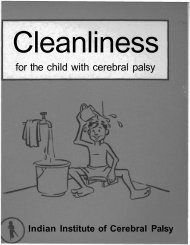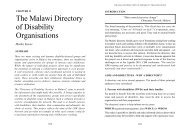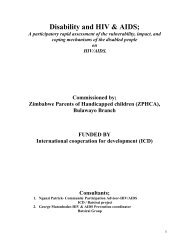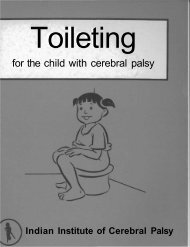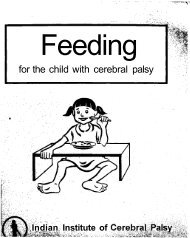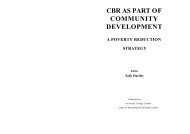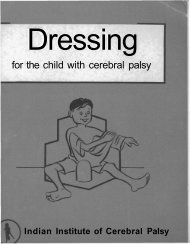Some Controversies in Community Based Rehabilitation - Source
Some Controversies in Community Based Rehabilitation - Source
Some Controversies in Community Based Rehabilitation - Source
Create successful ePaper yourself
Turn your PDF publications into a flip-book with our unique Google optimized e-Paper software.
CBR A PARTICIPATORY STRATEGY IN AFRICA<br />
countries had limited resources to provide high quality <strong>in</strong>stitutional<br />
services, the emphasis was on develop<strong>in</strong>g a method, which provided<br />
wide coverage, at costs that were affordable to the governments of these<br />
countries. In CBR, <strong>in</strong>terventions were to be shifted from <strong>in</strong>stitutions to<br />
the homes and communities of people with disabilities, and carried out<br />
by m<strong>in</strong>imally tra<strong>in</strong>ed people, such as families and other community<br />
members, thereby reduc<strong>in</strong>g the f<strong>in</strong>ancial costs (WHO, 1989).<br />
In the early eighties, CBR was conceptualised and evolved primarily as<br />
a service delivery method with a medical focus. WHO recommended<br />
that it be <strong>in</strong>tegrated <strong>in</strong>to the primary health care (PHC) system that was<br />
already well established <strong>in</strong> many develop<strong>in</strong>g countries. The International<br />
Classification of Impairments, Disabilities and Handicaps (ICIDH),<br />
published <strong>in</strong> 1980 by WHO, also encouraged a medical approach to<br />
rehabilitation (WHO, 1980). As a result, the early CBR programmes<br />
tended to focus on restor<strong>in</strong>g functional ability <strong>in</strong> disabled <strong>in</strong>dividuals,<br />
<strong>in</strong> order to ‘fit’ them <strong>in</strong>to their community. This was a sort of community<br />
located rehabilitation.<br />
Dur<strong>in</strong>g the eighties and the n<strong>in</strong>eties, there was a substantial growth <strong>in</strong><br />
the number of CBR programmes <strong>in</strong> different develop<strong>in</strong>g countries. Along<br />
with the quantitative growth, there were also major changes <strong>in</strong> the way<br />
it was conceptualised (Thomas and Thomas, 1999). One of the early<br />
changes was the shift from a medical focus to a more comprehensive<br />
approach. With the realisation that stand alone medical <strong>in</strong>terventions<br />
did not complete the rehabilitation process, CBR programmes gradually<br />
began to add on <strong>in</strong>terventions such as education, vocational tra<strong>in</strong><strong>in</strong>g,<br />
social rehabilitation and prevention. Along with this came the recognition<br />
that CBR needed to deal with issues relat<strong>in</strong>g to disabled people’s lives<br />
at all times, and to change not only the disabled <strong>in</strong>dividual, but the context<br />
<strong>in</strong> which he or she was located. Chang<strong>in</strong>g contextual factors <strong>in</strong>volves<br />
help<strong>in</strong>g non-disabled persons <strong>in</strong> the community accept people with<br />
disabilities, promote their social <strong>in</strong>tegration, and equalise their<br />
opportunities to access education and employment, <strong>in</strong> the same way as<br />
non-disabled persons. Protection of the rights of people with disabilities,<br />
14



